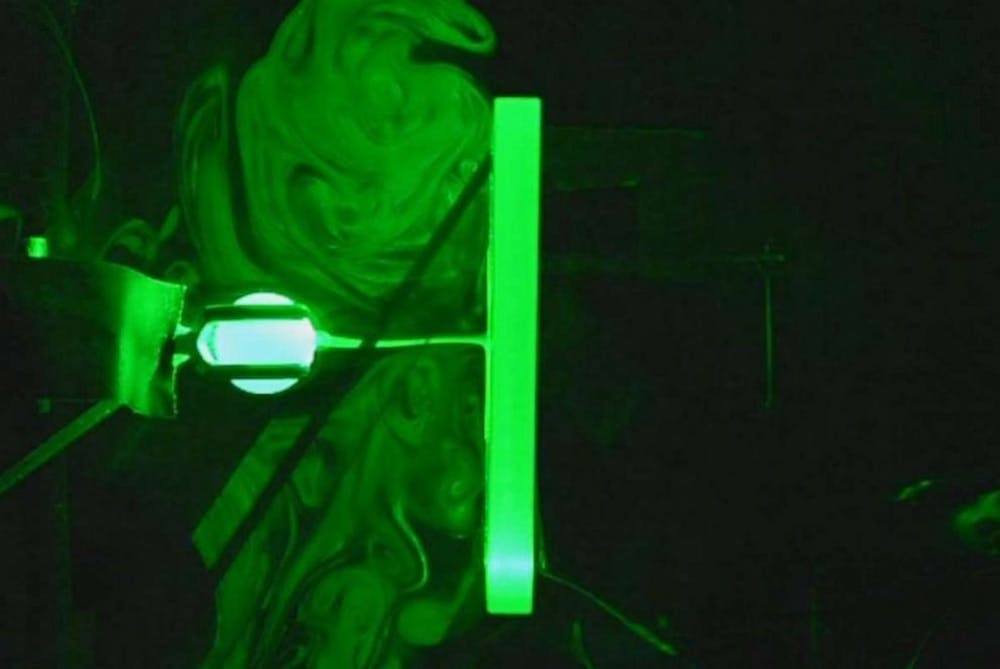A recent set of experiments led by mechanical and aerospace engineering professor Howard Stone investigated the effect of plexiglass barriers on airflow and virus transmission, highlighted in a recent segment on Good Morning America.
Since April, Stone has been investigating how speech-driven airflow plays a role in the transmission of viruses. The paper, published in September, found that speech “creates a conical, turbulent, jet-like flow” that can easily travel more than two meters in just 30 seconds of conversation.
Over the course of this pandemic, the use of plexiglass barriers to reduce virus transmission in public places has become widespread. After an ABC reporter reached out approximately three weeks ago, Stone and two of his graduate students, Nan Xue GS and Danielle Chase GS, set about experimentally modeling the interaction between speech-driven airflow and plexiglass barriers.
In an interview with The Daily Princetonian, Stone explained that the different types of droplets that come out of one’s mouth when speaking interact differently with plexiglass barriers. The large, visible droplets that fly out of the mouth “run into the barrier but don’t go through the barrier, so that stops them.”
On the other hand, Stone notes that aerosol particles, which are microscopic and contained in the air you breathe out, act very differently. These aerosols are so light that they remain airborne and follow airflow. Thus, when this exhaled air reaches a barrier, it is stopped in its direct path towards someone on the other side, but airflow can carry it around the edges of the barrier. The barrier can only confine or “reorient” the airflow and airborne particles to a degree.
Stone explains that such reorientation of airflow is beneficial as it allows for dilution of aerosols as the exhaled air mixes with ambient air in the room.
“That’s why ventilation in rooms is important,” Stone remarked.
Xue, a fifth-year graduate student in Stone’s lab, worked on this investigation as well. Xue explained that such research of speech-driven airflows and fluid mechanics can be useful in understanding how aerosols, especially coronavirus, are transported through air, which he hopes will be helpful in making guidelines and rules to promote safety.

The University has released an outline of a number of precautionary measures they are taking as they plan to welcome back undergraduates in the spring semester. Deputy University Spokesperson Michael Hotchkiss explained that such steps include “reducing the number of people on campus, requiring the use of face coverings, implementing an asymptomatic testing program and a symptom tracker for those authorized to be on campus, and rethinking operational practices.”
“In addition to these steps, physical modifications to spaces — such as the use of plexiglass barriers – are used when necessary,” Hotchkiss wrote in an email statement to the ‘Prince.’
Hotchkiss noted that although there aren’t standard guidelines for such barriers, “the University has designed its barriers for situations where two individuals must interact closely and cannot maintain social distancing.”
Currently, such barriers have been installed at check-in/check-out counters in libraries, the University Health Services building, and dining hall card-swipe desks. Hotchkiss emphasized the importance of wearing masks even when such barriers are present.

“It’s important to note that such barriers are not a substitute for wearing a face covering or following other public health guidance,” Hotchkiss wrote.
When asked for his opinion on the University’s use of such barriers, Stone noted that he had not been consulted by the University.
Stone explained that if such barriers were placed between individuals eating in a dining hall, the barrier would redirect the flow of aerosols, but proper ventilation of the dining hall with fresh air would be key to reducing the possibility of transmission. However, Stone emphasized that the barriers do not eliminate risk, but merely reduce the risk of transmission, and that other preventative measures such as wearing masks and social distancing are necessary.
Xue explained that wearing a mask reduces transmission of aerosols by blocking the jet-like airflow produced when a person is breathing, speaking, or singing. The “spreading jet” of airflow is redirected and becomes a laminar flow, in which fluid particles flow in adjacent layers without mixing, instead of a jet.
Since the air we exhale is hot, Xue elaborated, the effect of buoyancy carries the hot air containing aerosols to the top of the room or enclosed space. Therefore, proper ventilation is key, a point both Stone and Xue emphasized.
Stone explained that there are a wide variety of factors that play a role in preventing the spread of the virus, which he believes all need to be taken into consideration when planning for the reopening of campus.
“Can we do enough as a community to start to control the numbers? Can the vaccine start to work?” Stone asked. “Can we keep the numbers low enough and the testing rate fast enough that we can do this safely?”
Stone explained that the way scientists believe the virus is transmitted has played a major role in the guidelines written to reduce the spread, and these beliefs have been evolving “shockingly” fast.
“You’re allowed to be surprised,” Stone said. “I mean, we’re all allowed to be surprised!”
Stone concluded by expressing hope for the University’s plans to reopen.
“I’m glad the community is trying,” Stone remarked. “I think it's a challenge and that we as a state and we as a country find ourselves in a tough position, but I’m glad they’re trying.”








